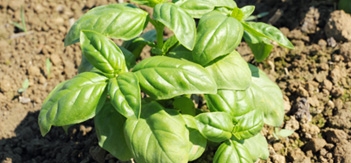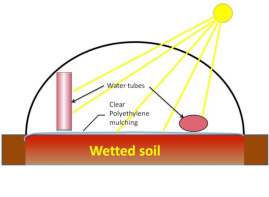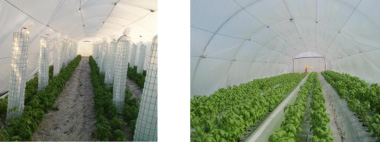An Innovative Way For Heating Greenhouses Using Solar Energy During The Winter For Summer Crop Production
As a result of increasing fossil fuel prices and restrictions on emissions of CO2 and other pollutants, there is a need to find alternative systems for heating greenhouses for growing vegetables and fresh herbs in the winter.

David Shapiroa*, Tzion Dekoa, Shahar Itshaka, David Silvermanb,
Mollie Sacksb, Uri Adlerc, Itzhak Esquirec and Yoram Stiglizd
a - R&D Emeq HaMaayont, Emeq Beit Shaan 11710, Israel
b --Extension service, Ministry of Agriculture, P.O. Box 30, Bet Dagan 50250, Israel
c - Plant Board, P.O. Box 235, Yehud 56000, Israel
d - Ginegar Plastic Products Ltd, Kibbutz Ginegar 36580, Israel
As a result of increasing fossil fuel prices and restrictions on emissions of CO2 and other pollutants, there is a need to find alternative systems for heating greenhouses for growing vegetables and fresh herbs in the winter. One possible alternative is the use of solar energy. Heating greenhouses during the night with solar energy requires a combination of several components based on the following principles: 1. absorption of the energy from the sun (during the day), 2. storing the energy and avoiding losses of energy to the surroundings and 3. using the energy at night. Absorption of solar energy is increased by covering the soil with a transparent plastic sheet. The wetted soil has a capacity to store a large amount of heat energy (fig 1). An additional method of absorbing and storing solar energy is by placing horizontal and vertical transparent PE (polyethylene) water tubes in the greenhouse tunnels (figs. 3 and 4). Using black PE to construct the water tubes allows for greater heat absorption than the commonly used transparent tubes.
The orientation of the greenhouse can also increase the absorption of solar energy. A walk-in tunnel orientated east-west will absorb substantially more energy than a similar structure orientated north-south. Placement of the self-supported vertical water tubes on the north side as a "wall of water" increases energy absorption and storage therefore raising greenhouse night temperatures up to 16 C0 in Israel, depending on local radiation and climatic conditions.
Losses of energy to the surrounding is reduced by covering the greenhouse with a double layer of plastic sheets with IR blockage, with a gap of air between the sheets or by the use of thermal screens or insulation blankets. From sunset when there is no more accumulation of heat, the water tubes and the soil release heat energy in to the volume of the greenhouse.
Similar practical applications of these principles are used elsewhere in the world. In parts of China solar energy is stored in a thick wall made from mud or clay bricks. In Israel we have applied these principles in walk-in tunnels for the growing of basil. The combination of these components have allowed us to grow basil (a summer crop) in the winter, while increasing production, preventing plant diseases, and improving quality while reducing costs and emission of greenhouses gases.
* Corresponding author: dashap43@gmail.com 2
 Figure 1: Absorption and storage of energy from the sun
Figure 1: Absorption and storage of energy from the sun
Using horizontal water tubes (fig. 2) is not a new method for it was tried years ago. Even though the horizontal tubes have some contribution to warming the greenhouse, they are located in the worst place in the greenhouse, the coldest and most shaded place, and they are exposed to mechanical damage. A unique solution of arranging the water tubes vertically (fig. 3) is a good and effective solution to the problems of the horizontal water tubes. They stand independently they are not supported by the greenhouse structure. They have a rigid frame made out of a metal sheet sleeve, or are supported by using a sleeve made from a metal wire mesh. The vertical tubes are exposed to the sun and they are not in the way of the workers in the greenhouse. It is possible to store a much greater volume of water in the greenhouse to enable greater storing of heat energy. Positioning the vertical tubes correctly reduces shading problems and is suitable for multi-span greenhouses and north-south orientations in walk-in tunnels (fig 4).

Figure 2: Vertical water tubes 3 Figure 3: Horizontal water tubes

Figure 4: The shading during the day due to vertical water tubes set in a north-south orientation.
The orientation of the walk- in tunnel has a major influence on the absorption of solar energy. The east- west orientation permits much more sun light to enter the greenhouse. In winter, when the sun is low, the sun beams hit the plastic covering of the north south orientated walk-in tunnel in a sharp angle (fig. 5). As a result part of the beam is reflected. The sun beams hitting the east- west orientation are almost at a right angle, which results in much more light entering into the tunnel, leading to higher yields (figs. 6 & 7).

Figure 5: The angle of the sun on the shortest day of the year when hitting north - south and east - west walk- in tunnels

Figure 6: Comparison of light intensities: outside versus eight north-south tunnels and one east-west tunnel.
Tunnels 2,4,6 and 8 have a double layer of plastic covering with a 10 cm air gap between the layers.

Figure 7: Basil yields from two tunnels of different orientations with soil mulching, water tubes and thermal screens
This knowledge gave way for the development and construction of the “Eden” greenhouse. The “Eden” greenhouse is oriented east – west and the vertical tubes are located on the north side. They form a “wall of water” (Figs 8 & 9). This location has an advantage that there is no shading on the crop and there is no physical disturbance to the workers. A relatively large amount of water can be kept in the walk in tunnel (8 m3 water in a 30 m length walk-in tunnel). The “wall of water” absorbs the solar energy during the relatively hot days and releases the heat during night, creating optimal temperatures for crop production.

Figure 8: “Eden” Tunnel showing the wall of water: a. front perspective view, b. volume of water relative to the tunnel length

Figure 9: “Wall of water” made of black PE water tubes
The reason for using water in the tubes is the high specific heat of water compared to other materials. Water is available and will not contaminate the soil if the tubes are damaged. A thermal picture that was taken at night shows the heat stored in wall of water and the influence on plant temperature (fig.10). The yield of the basil crop was significantly higher in walk-in tunnels equipped with a wall of water (fig. 11).

Figure 10: The night temperature in the walk-in tunnel due to the “water wall made from black PE.

Figure 11: Comparison of different treatments in tunnels on basil yield: Water wall versus with or without water tubes
In conclusion, we developed a simple, sustainable, nonpolluting, no emissions system for growing summer crops in winter by raising the temperature using only solar energy. It is possible to grow basil crops in the winter in Israel by using: PE mulching, water tubes, thermal screens and double layers of PE covering material. The best results were achieved by using a wall of black PE water tubes standing on the north side of the east-west orientated tunnel. Orientating the tunnel in an east-west direction has a considerable advantage over north-south orientated tunnels. This method made it possible to grow basil free of winter diseases without needing chemical spraying of fungicides. Depending on the climatic conditions there is a possibility of using only some of the aforementioned methods to produce high yields of excellent quality.